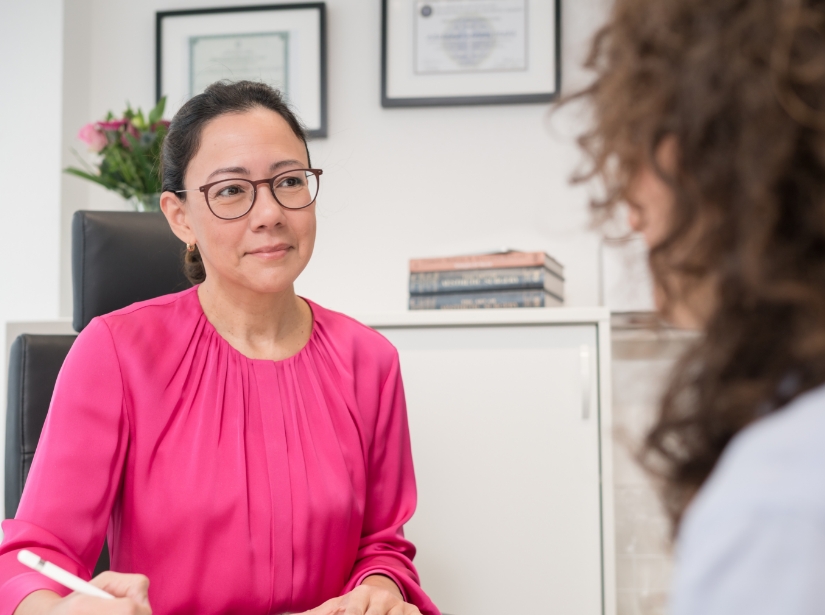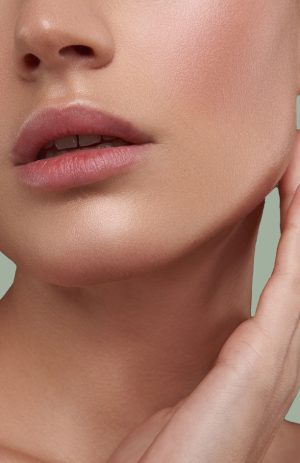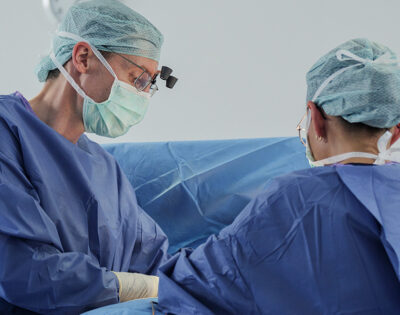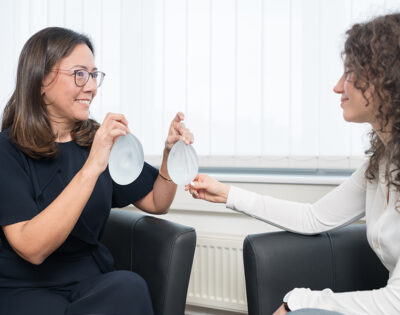Recognize & treat skin cancer
The cells of the skin change with age and after intensive exposure to sunlight or UV radiation. Certain changes in the genetic material can lead to uncontrolled cell proliferation. The external appearance of the skin change in question does not always allow an exact assessment of whether the skin phenomenon is benign or malignant. In the case of benign changes, the cells remain together; in the case of malignant changes, the cells spread throughout the body and form metastases. The histological examination of the removed skin area offers the greatest possible certainty in differentiating between benign and malignant skin changes.
What our patients say
Skin tumors
Common benign skin tumors are:
- Moles (nevus cell nevus) are an accumulation of pigment cells in the skin. Certain characteristics may indicate a malignant change (ABCDE rule: A for asymmetry; B for boundary; C for color; D for diameter; E for development).
- Hemangiomas are vascular malformations.
- Port-wine stains (nevus flammeus) are flat vascular malformations that are already present at birth.
- Xanthelasma are cushion-like fat deposits in the area of the upper and lower eyelids, occasionally an expression of a lipometabolic disorder. They are harmless, cause no discomfort, but are perceived as cosmetically disturbing.
- Stalk warts (fibromas) are a proliferation of cells of the connective tissue.
- Age warts (seborrheic keratosis) are a proliferation of horny cells.
- Warts are growths of epithelial cells that can be caused by viruses and can therefore be contagious.
Common malignant skin tumors are:
- White skin cancer (basal cell carcinoma) is a malignant proliferation of skin cells in the basal layer of the epidermis. Tumor metastasis is very rare (0.0028-0.55 %).
- Black skin cancer (malignant melanoma) is a highly malignant proliferation of pigment cells in the skin.
- Light skin cancer (squamous cell carcinoma, spinalioma) develops from cells in the epidermis. It can destroy the surrounding tissue and also form tumor metastases.
How is the removal of a skin tumor performed?
The procedure is performed (as required) under local anesthesia, general anesthesia or twilight sleep. For a local anesthetic, either the skin in the area to be operated on is anesthetized or only the nerve that supplies the surgical area is specifically anesthetized. During twilight sleep, you will also receive sedatives and painkillers via the bloodstream. For an optimal, gentle surgical technique and to minimize your blood loss, an adrenaline solution is injected under the skin. The visible skin change is cut around in a spindle shape. Smaller vessels are then sclerosed using the bipolar technique. Benign skin changes that can be easily demarcated are then closed.
In the case of malignant skin tumors, surrounding healthy tissue is also removed to increase the safety of complete removal. The margin, in which no visible tumor tissue can be seen, is called the safety margin and can be up to 2 cm. In the case of certain malignant skin tumors, the removal of sentinel lymph nodes may be recommended. Methylene blue and/or radioactive heavy metal is used to visualize these lymph nodes. Appropriately marked lymph nodes are removed for histopathological examination. Malignant skin changes that cannot be clearly delineated are initially only sterilely bandaged. The wound may remain open until the final results of the tissue examination are available. Only when it is certain that the tumor has been completely removed is the wound closed in a second procedure. Ideally, very fine threads are used and sewn under optical magnification. The wound edges are adapted precisely and gently to ensure rapid healing of the wound and inconspicuous scars. Depending on the size and location of the tumor, the operation can be performed on an outpatient or inpatient basis. Local flap plasty (local tissue displacement) is often necessary to close the wound.

1 Skin change 2 Epidermis 3 Corium 4 Remains of the tumor tissue must be removed before the wound is closed 5 Skin nerves 6 Subcutaneous fatty tissue 7 Vessels 8 Muscle tissue
How are wounds closed?
As part of a normal healing process, wounds have a tendency to heal themselves. Replacement tissue forms, which is transformed into scar tissue over time. The scar tissue contracts and can lead to a cosmetically and functionally unsatisfactory result. Depending on the initial findings, the wound may take months to heal or may not heal at all. As long as the wound is not closed, germs can colonize the wound and lead to inflammation. Wound closure is intended to accelerate healing and make it more difficult for germs to enter the body. Wounds differ in terms of the areas of the body affected, the healing process, the size, the causes and the risk of inflammation. There are therefore different techniques for restoring the body surface. The choice of method depends on the patient’s personal preferences, the characteristics of the wound and the general state of health. An aseptic or low-germ wound is a basic prerequisite for surgical wound closure. Superficial wounds with a well-perfused wound bed are generally suitable for skin grafting. There are two main types of skin grafting which differ according to the thickness of the skin graft. A thin-layered graft (split skin) has a lower load-bearing capacity, a greater tendency to shrink and a noticeably different color. In comparison, a thicker skin graft (full-thickness skin) is more resilient and stretchable. The shade of color depends, among other things, on the part of the body from which the skin was removed. Deep and large wounds can be closed by moving adjacent tissue (flap plasty). Due to the thickness of the tissue and its proximity to the wound, a flapplasty is characterized by high resilience and elasticity as well as a favourable cosmetic result. In order to be able to move the neighboring soft tissue, it must be loosened. This inevitably results in further scars and smaller vessels and nerves are injured.

1 Wound 2 Tissue to be detached (incision) 3 Vascular mesh
Skin cancer treatment procedure

Preparation
- All your questions about possible complications and alternative treatments should be answered in advance.
- Keep nicotine and alcohol consumption to a minimum!
- The intake of hormone-containing medication (pill) may have to be temporarily discontinued.
- Blood-thinning medication (e.g. ASA, Thomapyrin®) must be discontinued at least 10 days before the operation after consultation with your doctor.
- Vitamin preparations (A, E) and dietary supplements (omega-3 fatty acids, St. John’s wort preparations, etc.) must be discontinued at least 4 weeks before the operation.
- Surgeries restrict the ability to travel by air. Therefore, do not plan any business or private air travel in the 6 weeks following the operation!

The intervention
- First, the suspicious tissue is removed, usually on an outpatient basis and under local anesthesia.
- Until the histological examination confirms complete removal, the wound is treated with a special dressing.
- The duration of wound closure depends largely on the complexity of the wound (20 minutes to 4 hours).

After the procedure
- After outpatient removal of the skin lesion, driving should be strictly avoided due to any concomitant medication.
- The skin threads are removed after 7 to 14 days, depending on the affected area of the body.
- Showering is possible immediately before the wound check on the 3rd postoperative day.
- Scar care (scar massage, sun protection, silicone pad) from the 3rd postoperative week onwards helps to achieve inconspicuous scars.
- Sports, saunas, swimming, heavy work and sunbathing should be avoided for at least three months. 4 weeks should be avoided.
- Postoperative clinical checks are recommended on the 3rd postoperative day and after 1, 2 and 6 weeks.
- After removal of a skin cancer, regular follow-up care by a dermatologist is recommended every 3 to 6 months.

AUTHOR
Dr. Stéphane Stahl
We provide you with extensive expert knowledge in order to select the best possible treatment path together with you.
Privatdozent Dr. med. Stéphane Stahl is the former Director of the Clinic for Plastic, Reconstructive and Aesthetic Surgery / Hand Surgery at Lüdenscheid Hospital. Dr. Stahl studied medicine at the Universities of Freiburg and Berlin.
He passed the European specialist examination for plastic and aesthetic surgery in 2011 and the German specialist examination in 2012. This was followed by further specialist qualifications and additional qualifications (including quality management, medical didactics, physical therapy, emergency medicine, laser protection officer, hand surgery) as well as prizes and awards.
In 2015, he completed his habilitation in plastic and aesthetic surgery in Tübingen. He is an experienced microsurgeon, sought-after expert witness and regular speaker at specialist congresses. Following a multi-stage selection process, Stéphane Stahl became a member of the American Society for Aesthetic Plastic Surgery (ASAPS), one of the world’s largest and most influential specialist societies for aesthetic surgery.
His authorship includes numerous articles in prestigious peer review journals and standard surgical textbooks.
You might also be interested in

Personal advice
We take time for you and offer you customized advice and treatment for your individual result.









